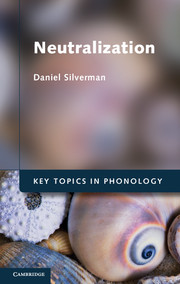Book contents
- Frontmatter
- Contents
- List of Figures
- Preface
- Acknowledgments
- 1 The rhyme and the reason of neutralization
- Part I Rhyme
- Section A Observation and description
- 2 Topology
- 3 Taxonomy
- 4 Typology
- Section B False positives
- Section C Explanation
- Section D Exemplification
- Part II Reason
- Glossary
- References
- Language index
- Subject index
2 - Topology
Published online by Cambridge University Press: 05 November 2012
- Frontmatter
- Contents
- List of Figures
- Preface
- Acknowledgments
- 1 The rhyme and the reason of neutralization
- Part I Rhyme
- Section A Observation and description
- 2 Topology
- 3 Taxonomy
- 4 Typology
- Section B False positives
- Section C Explanation
- Section D Exemplification
- Part II Reason
- Glossary
- References
- Language index
- Subject index
Summary
In the broadest sense of the term, neutralization involves the dynamic reduction and/or the static limitation of contrastive values within a lexical form. Segmentally speaking (“segment” being a theoretical construct we will abandon), these reductions and/or limitations result in a speech signal that is not temporally uniform with respect to the amount of phonologically significant material it encodes. Rather, the speech signal consists of time periods with more phonologically significant information (contrastive cues) interwoven with time periods of less phonologically significant information (the suspension or loss of contrastive cues). The informational output across the temporal duration of a spoken lexical form thus rises and falls as a consequence of cue expression and cue neutralization. We may characterize this ever-changing rate of information-encoding in any number of ways, but in this chapter we focus on one characterization in particular. Specifically, we consider the topological malleability of informational content with respect to its temporal encoding within lexical forms. Thus, reductions in informational content may be characterized with respect to what temporal components of the lexical form they affect. These include (1) spans, (2) edges, and (3) points. As discussed in subsequent chapters, in most instances, topological constancy is indeed maintained despite this malleability, in the sense that lexical semantic content almost always remains unchanged.
Neutralization affecting spans includes any and all patterns of cue reduction that manifest themselves across some expanse within the lexical form, typically falling under the rubric of assimilation. These include vowel and nasal harmony systems, for example, but also more local forms of assimilation, such as nasal place assimilation and other sorts of word-internal place and laryngeal assimilations.
- Type
- Chapter
- Information
- Neutralization , pp. 15 - 30Publisher: Cambridge University PressPrint publication year: 2012



